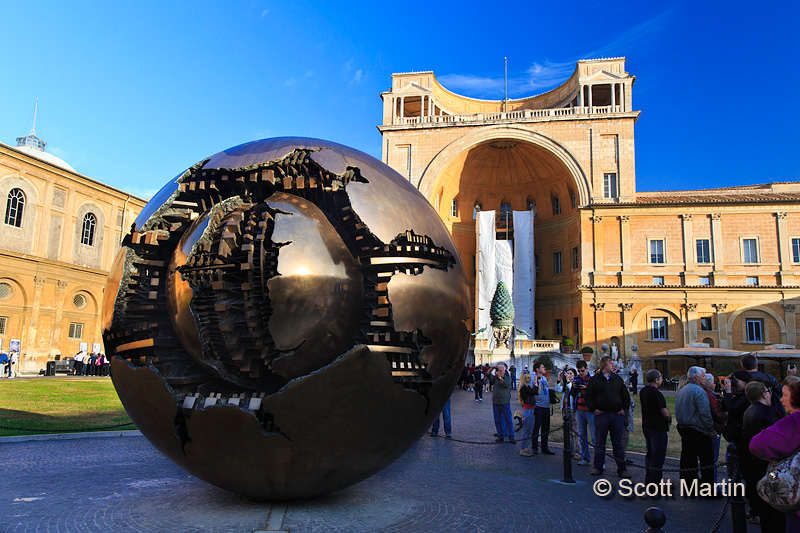
by Scott Martin Photography | Oct 5, 2013 | Blog, Cityscapes, Educational, Landscapes, Travel
The Vatican Museums are a collection of many museums located within the walls of Vatican City. The first museum was initiated by Pope Julius II in 1503 and generally speaking the popes were the first European sovereigns who opened their palaces to the public introducing the public to their extensive art collections and with that a better understanding of art history and culture. In 2006 the Vatican Museums celebrated their 500th birthday and now there are approximately two dozen museums averaging more than 5,000,000 visitors every year.
Admission to the museums, which includes the Sistine Chapel, is €16 however make sure you purchase your tickets online before heading to the Vatican which allows you to completely skip the que and head directly into the museums. This will save you up to three hours in line if you are in Rome at the height of the tourist season.
Deb & I took hundreds of pics as we wandered through as many sections of the museums as we could fit in and it was clearly a case of sensory and information overload as we tried to absorb and remember as much as we possibly could.
Although the art contained in the Vatican Museums is typically ancient, the central Courtyard of the Pinecone contains a large sculpture that was very cool however seemingly out of place with surrounding artefacts.

Named ‘Sfera con Sfera’ or Sphere within a Sphere, it is just over 13 feet in diameter and although it must weigh many tons it easily spins around its axis with a little elbow grease. The Pinecone (Pigna) in the back ground from which the courtyard gets its name is a first century Roman bronze that was originally the working centrepiece of a fountain located near the Pantheon. It is about 13′ high and was moved during the middle ages to the courtyard of the original St. Peter’s Basilica and then to its present location in 1608.
Although there are many ‘typical’ museum displays, the Vatican Museums catalogue and store thousands of artefacts which line the corridors of the many buildings that comprise the museums.
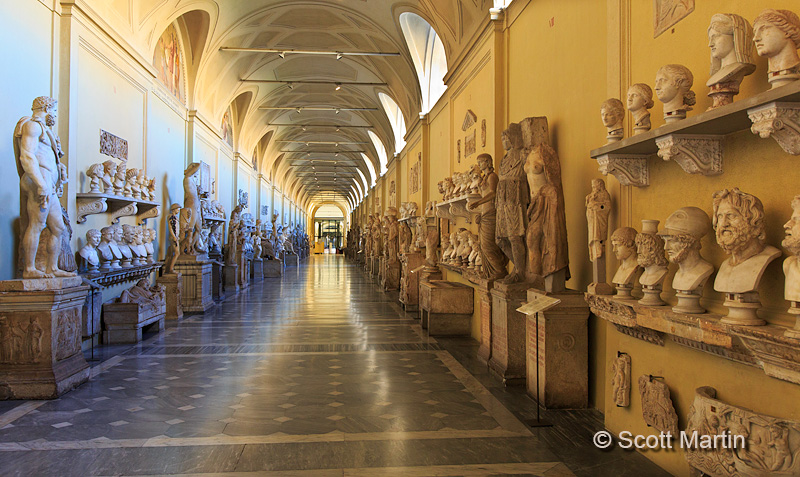
Located in the Round Room of the museum are two objects that were quite interesting, a gilded bronze statue of Hercules and one of the bathtubs from Nero’s palace.
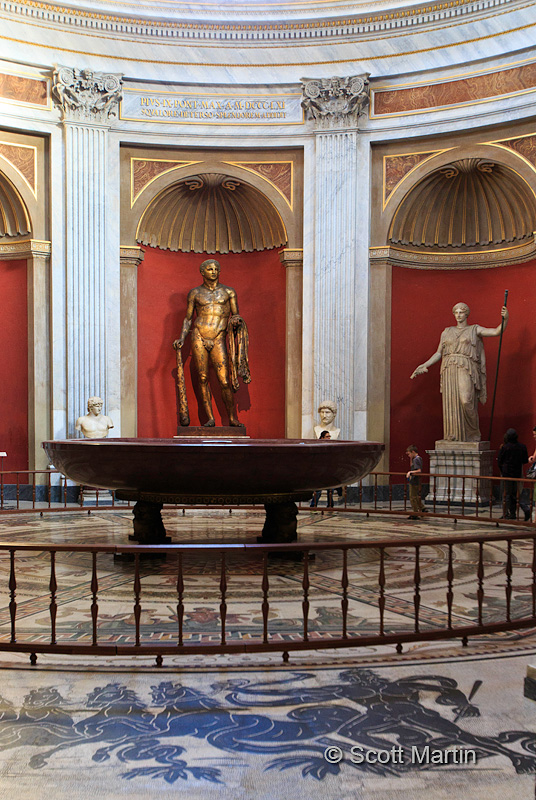
Nero was the Emperor of Rome from 54-68 AD. An evil tyrant who was a fierce opponent of Christianity, being responsible for the execution of thousands of Christians. His life was characterized by hedonistic excess that was epitomized by his royal palace, the Domus Aurea (Golden House) which he built after the great fire of Rome in 64 AD. In fact, it has been alleged that Nero started the fire in order to make room for his palace, hence the phrase “Nero fiddled while Rome burned”. Nero had his own mother executed as well as one of his wives and his step-brother was poisoned apparently at Nero’s direction. In 68 AD after being ousted from power, he committed suicide, the only emperor to do so.
At some level Nero’s life is represented by the bathtub pictured above. It was constructed of the rarest marble in the world, called Porphyry for its deep purple colour. Reserved for royals and only found on an Egyptian mountaintop some 800 km from Rome where it was mined by convicts and imprisoned Jews and Christians. Nero’s bathtub is almost twenty feet in diameter and stand almost six feet high on its ornate legs (note the people in the picture above for a reference point). The tub is valued at $100,000,000.00.
So while Nero rejected God and executed the Christians of the first century church, who did he worship? Probably the mythological Greek gods, like Hercules, who is seen above overlooking Nero’s bathtub. The gilded bronze larger than life-size statue of Hercules that stands in the Vatican is thought to date back to the first century. It was found in 1864 neatly buried under travertine stones in the area that was once Pompey’s Theatre. The stones protecting the statue were engraved with the letters FCS which means that the statue was struck by lightning and according to Roman tradition granted a ritual burial together with the remains of a lamb.
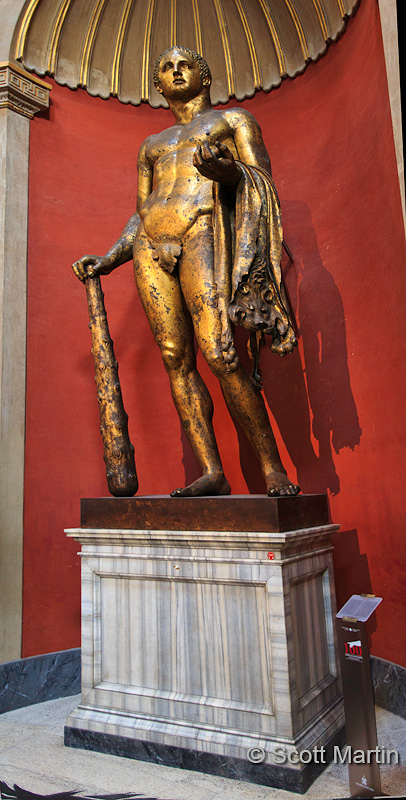
The detail contained in artworks of the past are impressive as shown in the white marble animal below that functions to support the marble base that rests on its back.
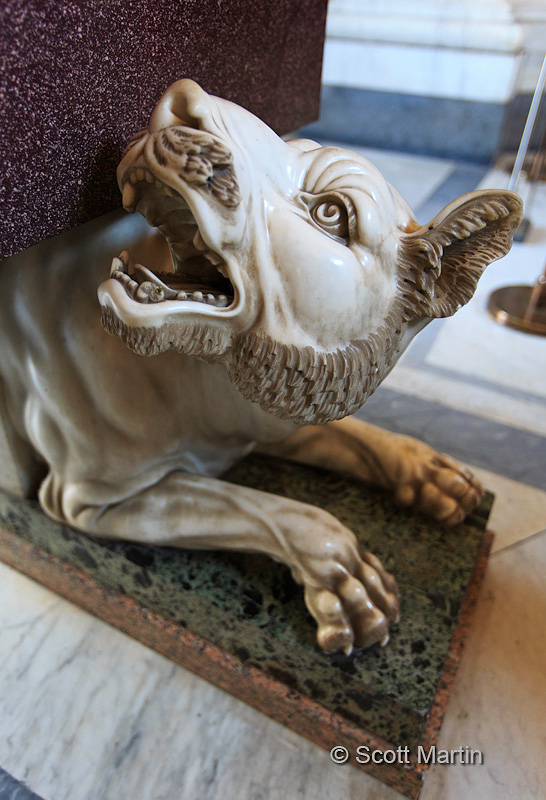
The Gallery of Tapestries contains a number of Flemish tapestries that were made in Brussels in approximately 1523 and first displayed at the Vatican in the Sistine Chapel in 1531. The tapestries were given their own gallery in 1838 and remain there today. The exquisite detail and colour in the stitching of the tapestries is incredible, especially when you consider they are almost 500 years old. You forget they are essentially carpets so in the image below I’ve purposely kept the edge visible on the right to remind you. The tapestry is titled Supper at Emmaus showing the risen Lord eating with the men He joined while walking to Emmaus (Luke 24:13-35).
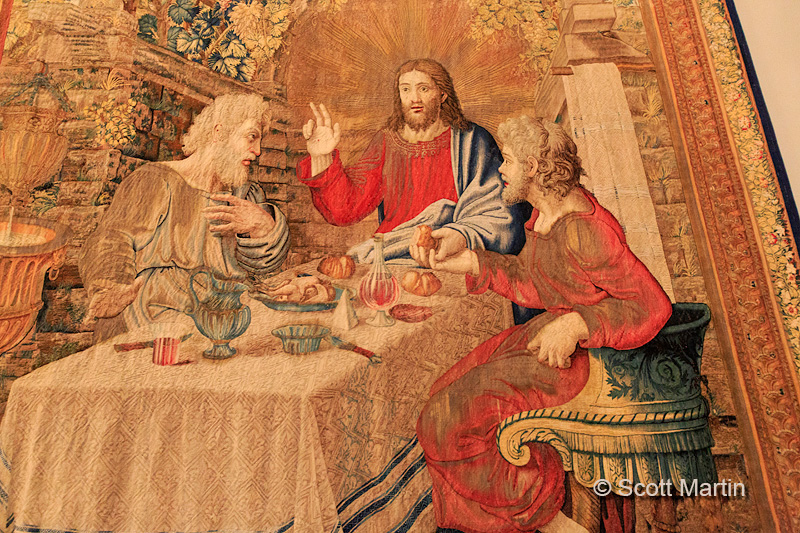
Probably one of the most popular galleries in the Vatican is the 120m hallway leading towards the Sistine Chapel known as the Gallery of Maps. Commissioned in 1580 by Pope Gregory XIII it contains 40 large topographical maps of Italy. The gallery took three years to build and has a ceiling that is as impressive as the maps that adorn its walls.
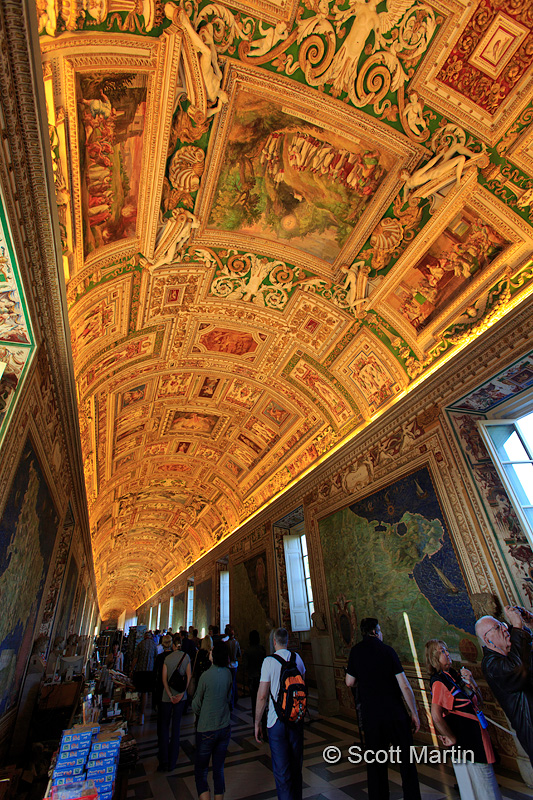
At the end of the Gallery of Maps you go down a small narrow flight of steps, pass through a rather nondescript doorway and find yourself in one of the most visually stunning rooms in the world, the Sistine Chapel; the Pope’s private chapel and home to Michelangelo’s most famous works that adorn the walls and ceiling. The Sistine Chapel is perhaps the world’s most well-known chapel and one of its oldest with construction through 1473-1481. It is part of the Papal Palace and is interesting in that it lacks a grand entrance typical of churches and there are no entrances or exits directly to the outside. The Sistine Chapel measures 134 x 44 feet, patterned after the size of Solomon’s Temple. The vaulted ceiling rises 68′ above the floor.
When entering the chapel for the first time, it was the vibrancy of the colours that surprised me the most. I was expecting subdued colours, especially on paintings that are 500 years old, however they are actually bright and vibrant.
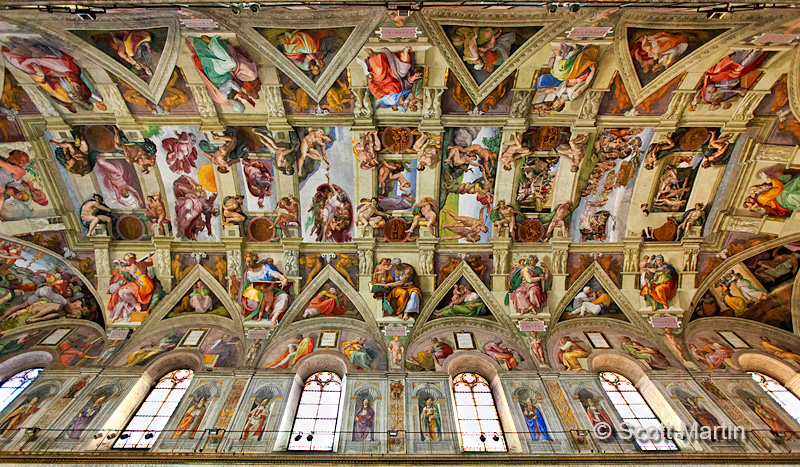
Michelangelo was commissioned by Pope Julius II in 1508 to paint the ceiling, which he completed between 1508 and 1512. In total the frescos painted on the ceiling covered over 5,000 square feet and contained more than three hundred figures.
Michelangelo painted “The Last Judgement” on the wall behind the altar from 1535-1541.
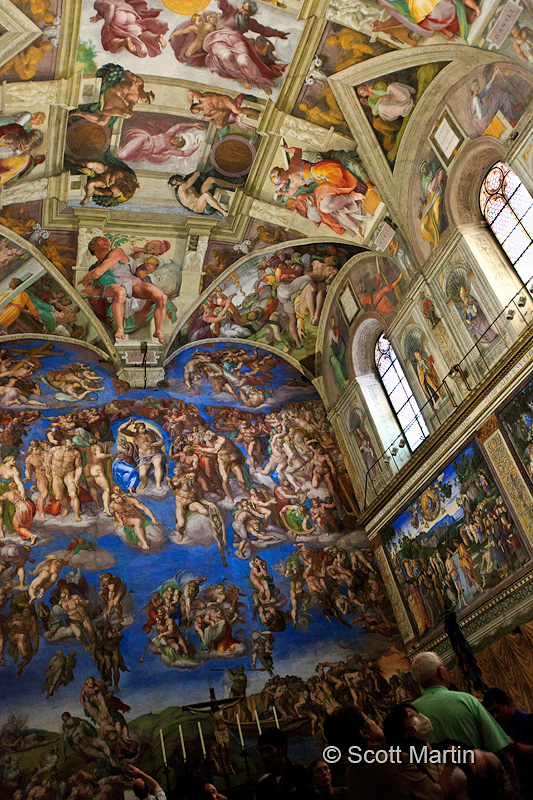
There is some debate whether Michelangelo painted the ceiling lying down or standing up. Either way it is generally agreed that scaffolding was built at a level above the top of the windows which would by design block the viewing of the ceiling from the floor beneath. This means that the figures on ceiling were painted without the benefit of having the proper proportional perspective that would be available from the floor. That Michelangelo could paint such large figures at such close range and maintain proper proportional relationships is truly remarkable as demonstrated in “The Creation of Adam”, perhaps the most famous of the ceiling panels.
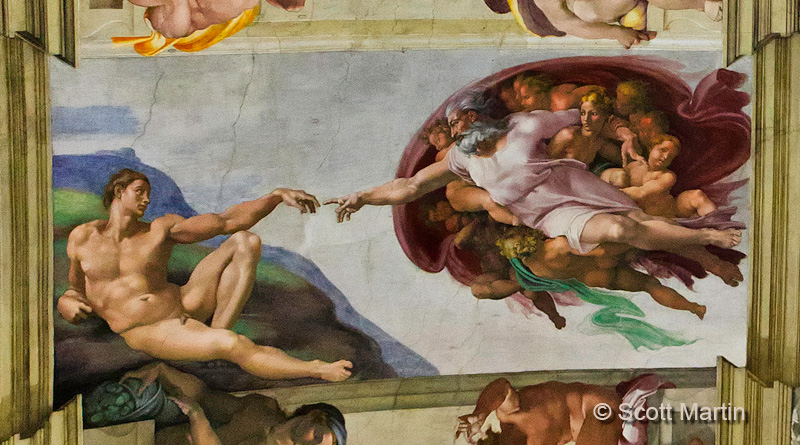
We left the Sistine Chapel and headed through a small maze of hallways that comprised a short cut to St. Peter’s Basilica, along the way passing a small store selling Vatican remembrances.
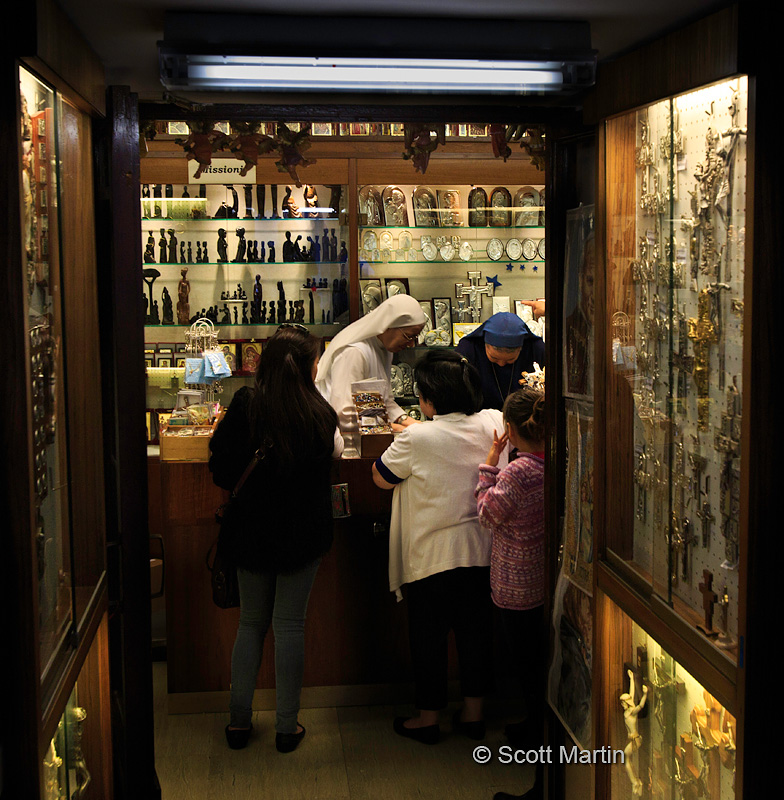
One of the many things I will remember from our day at the Vatican was the sheer size of everything, which is quite ironic given that the Vatican is the smallest country in the world. Even in an alleyway between the Sistine Chapel and St. Peter’s Basilica that sees little traffic, the person in the bottom of the next image provides a great example of the scale of the Vatican.
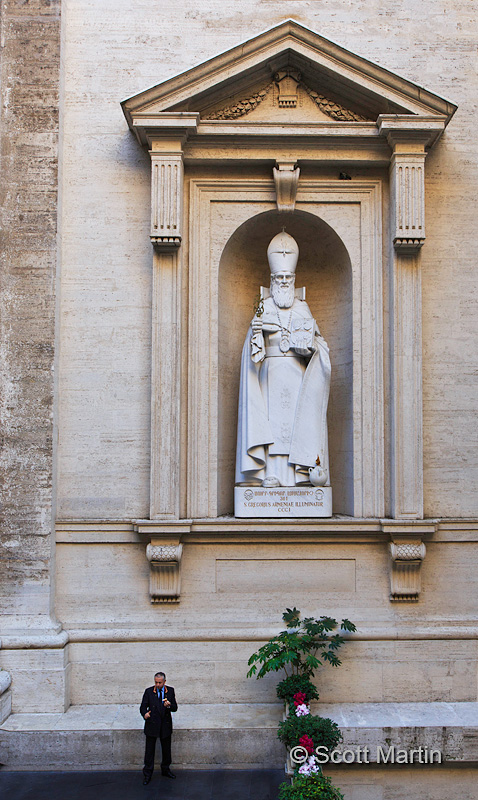
After concluding our time in Rome we headed to the train station to pick up our rental car and begin the next leg of our trip; the 540km drive to Venice, which will be the subject of the next blog posts.
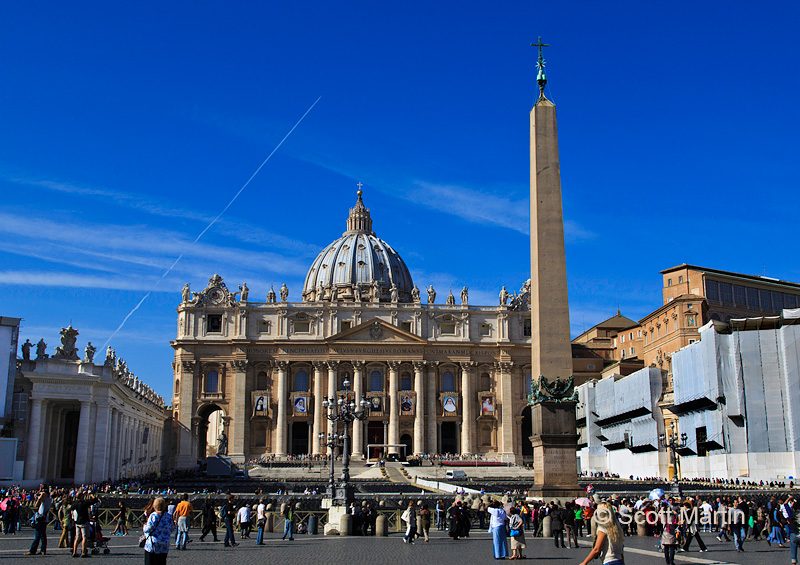
by Scott Martin Photography | Oct 2, 2013 | Blog, Cityscapes, Educational, Travel
Vatican City is a 110 acre walled enclave within the City of Rome which has about 840 permanent residents. The Vatican City State was formally recognized as a sovereign state in 1929 making it the smallest internationally recognized State whether measured by geographic size or population. The fortification walls that define the Vatican were constructed under the rule of four popes between the years 847-1644. Although the Vatican now uses the Euro as currency, they do mint Vatican Euro coins which are highly sought after by coin collectors, as are Vatican postage stamps. The sale of stamps and coins is one of the Vatican’s prime methods of generating income for the state. The Pope is the sovereign head of the Vatican City State, having full and absolute executive, administrative and judicial power over Vatican City making him the only absolute monarch in Europe.
Deb & I spent a full day touring the Vatican, which included climbing some 500 stairs to the top of the cupola high above St. Peter’s Basilica which provided a fabulous view of St. Peter’s Square and the surrounding city of Rome. While in the basilica we also met and had a chance to chat with an Arch Bishop and a Cardinal which was a pleasant surprise. The buildings, churches, museums and chapels that make up the Vatican are visually stunning and it is difficult to properly capture their beauty photographically however I trust the images within this post give you a small sense and appreciation of the Vatican.
St. Peter’s Basilica and St. Peter’s Square with the Vaticano Obelisk at its centre form the classical view of the Vatican. The obelisk was carved in Egypt in 30 BC and brought to Rome in 37 AD. It is one of eight Egyptian obelisk’s in Rome and the only one that has not toppled since Roman times.

We were at the Vatican the day before the Pope presided over the canonization of seven people and as a result St. Peter’s Square was set up with chairs for the many thousand who would attend the service. The pictures of those being canonized were framed on the face of the basilica, including Kateri Tekakwitha, a Native Canadian who died 300 years ago when she was only 24.
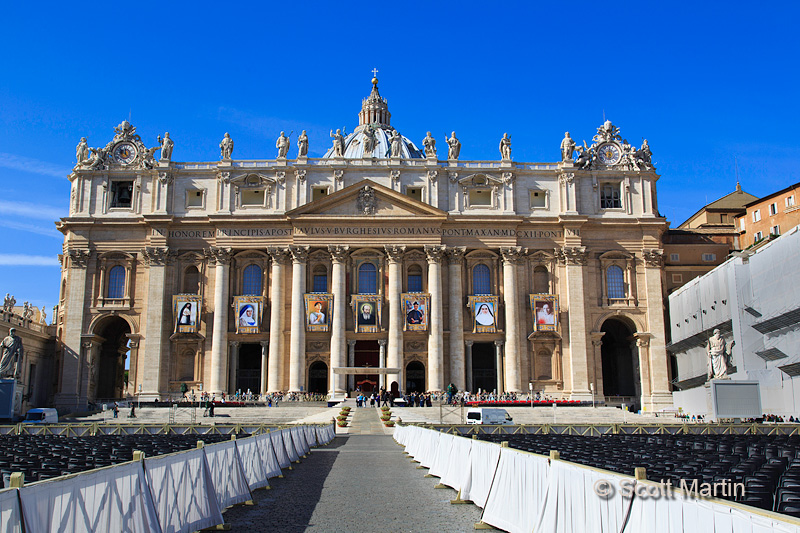
The Pope’s apartment over looks St. Peter’s Square and he addresses people from the top floor, second window from the right.
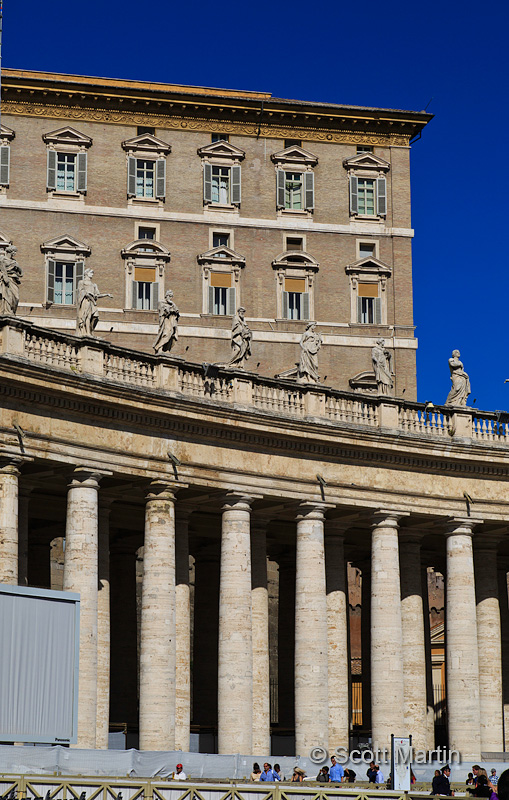
Upon entering St. Peter’s Basilica one is first taken aback by the sheer size of the church. It is so big it is hard to get a proper perspective. The church is designed in the shape of a Greek cross with a large central dome that covers the Papal Altar which can be seen in the back ground of this snap from inside the doors of the church.
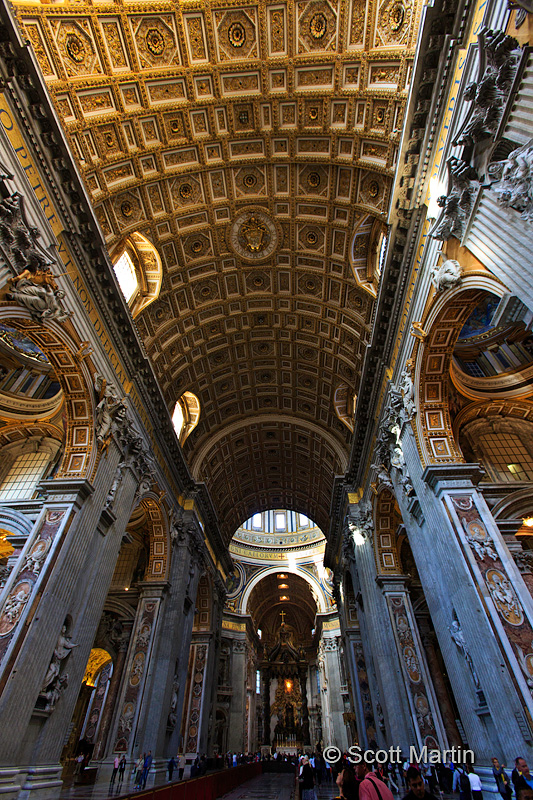
There were a number of architects involved in the design of the basilica which was constructed in the early sixteenth century, most notably Michelangelo who was in his seventies when asked take over the design and construction of the church.
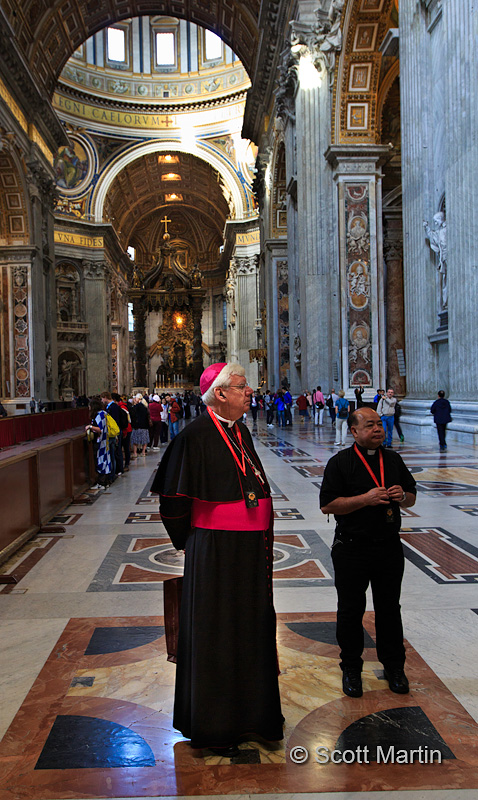
The basilica is probably the largest church building in the world covering almost six acres in area. The Papal Altar, covered by the central dome of the basilica is the central focus of the church. Only the Pope can use this altar, which is constructed over at least two others that preceded it and all covering the burial site of Peter, who was crucified upside down in 64 AD near the Egyptian obelisk that stands in the centre of St. Peter’s Square only a few hundred feet away from the altar.
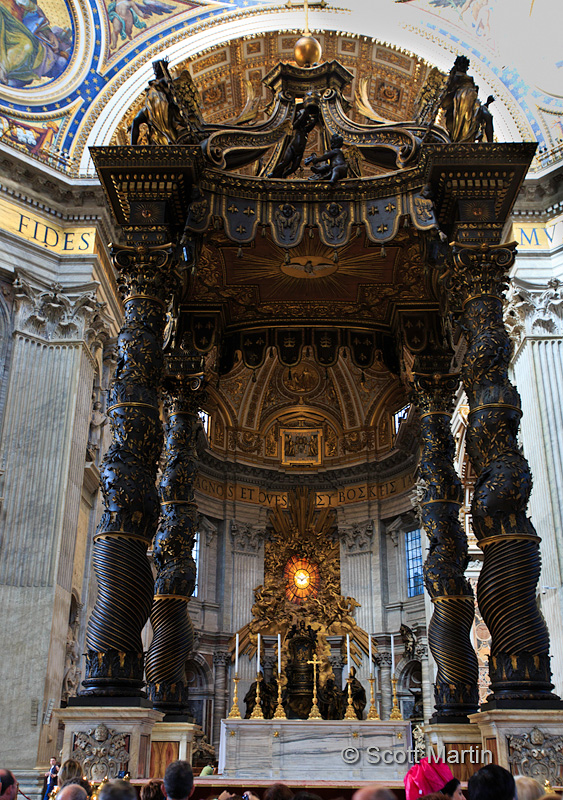
The actual altar is quite simple by Vatican standards consisting of a giant slab of Greek marble but the canopy, or baldacchino, that covers it is the visual centre piece of St. Peter’s Basilica. It is formed from a vast block of black Greek marble, gilded in bronze and standing ninety-five feet above the altar. The Papal Altar was consecrated in 1594 while the canopy was designed by Bernini and built in 1624.
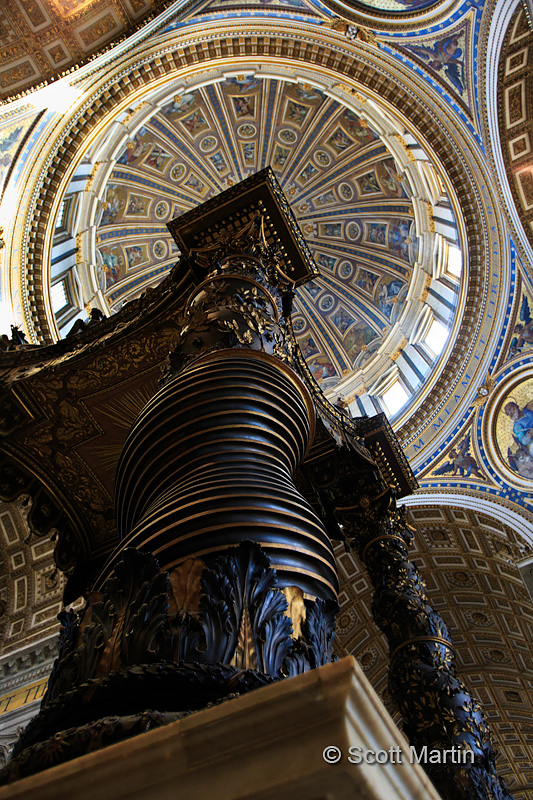
Directly below the Papal Altar is Peter’s tomb which is also below the grade of the main floor of the basilica. When a new Pope takes the historic walk to his investiture it begins at this tomb. Note the people at the sides of this next image to give perspective to the sizes involved.
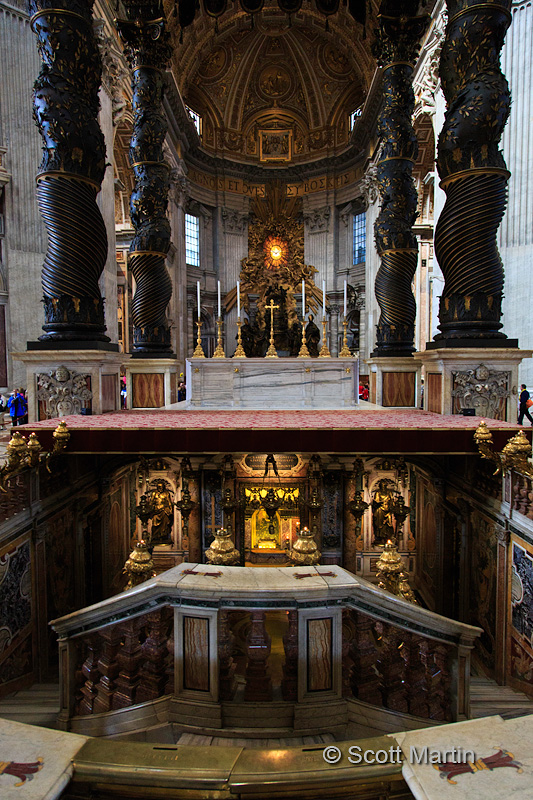
Throughout the basilica there are many altars, confessionals, and works of art, all of which could be greatly expanded upon however for the sake of brevity I will only highlight a few. The first is the Cathedra Petri or Throne of St. Peter which was designed by Bernini and contains a chair that was originally said to be used by Peter himself however was subsequently shown to be from the twelfth century. Still a very old chair! The altar was completed in 1666.
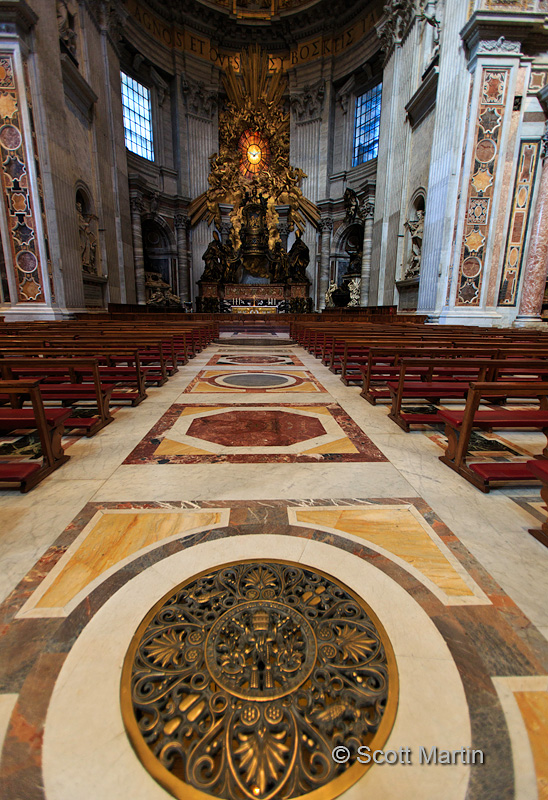
The Altar of Saints Processus & Martinian (two Roman jail guards converted by Peter while awaiting his crucifixion).
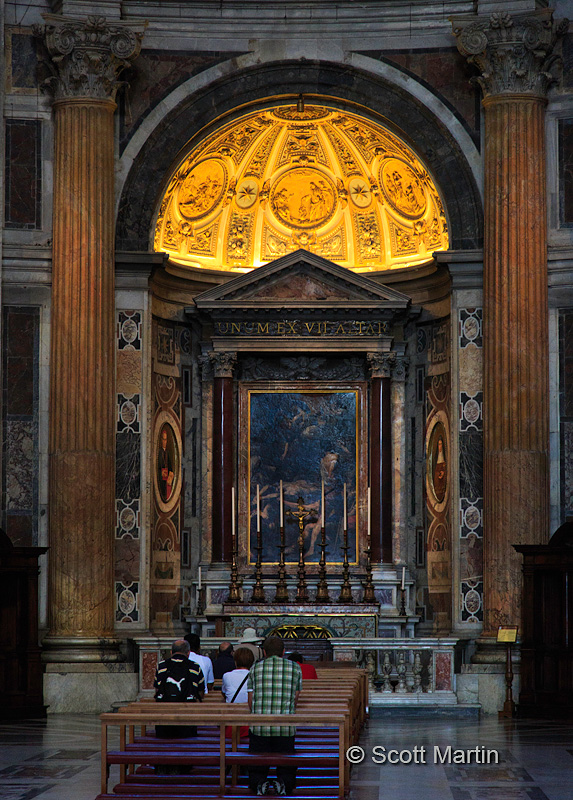
One of many confessionals in the basilica.
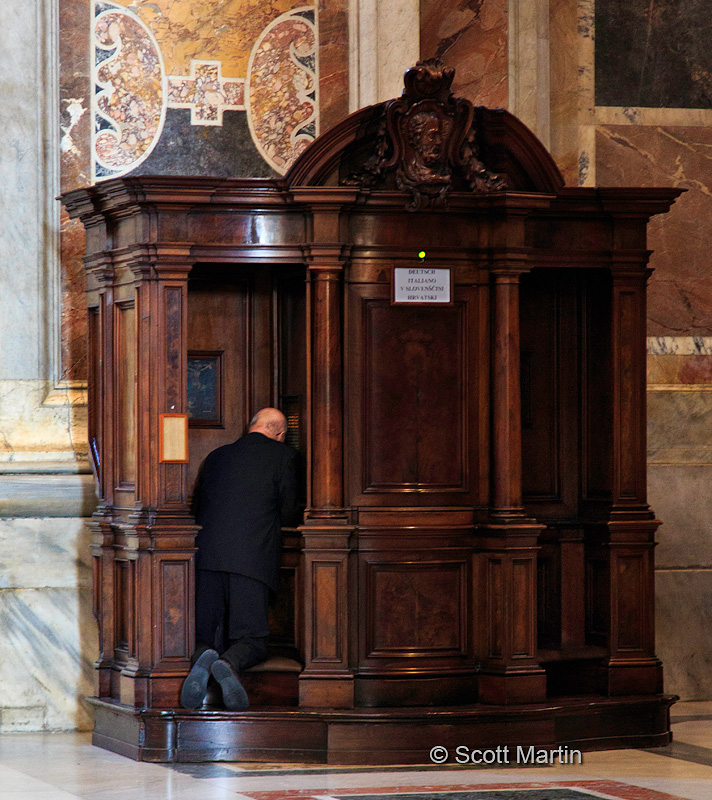
The statue of St. Peter is one of the most popular in the basilica and devotees line up to touch and kiss the right foot of the statue. This is a practice so common that the foot has been completely worn down by the countless people who have attended the statue since it was created in 1296.
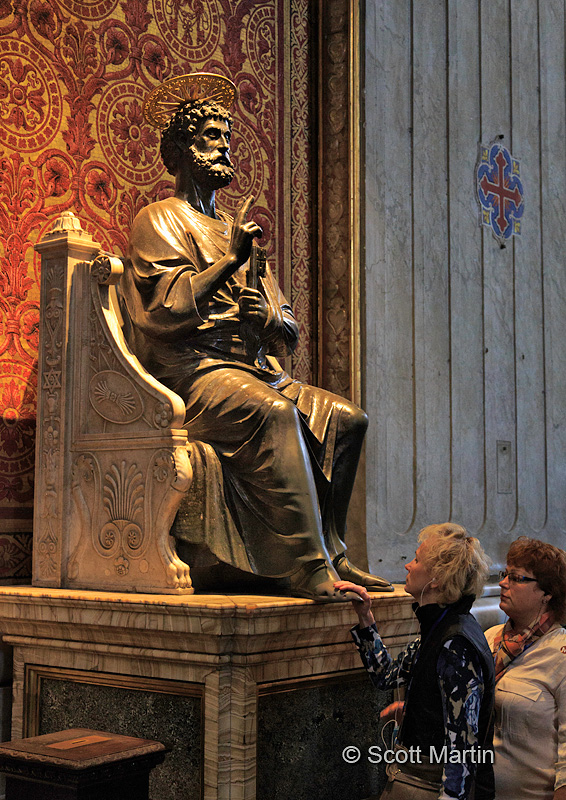
Beneath the Altar of St. Jerome is the resting place of Pope John XXIII who died in 1963. Just last week on September 30th, Pope Francis announced that Pope John XXIII and Pope John Paul II will be declared Saints on April 27, 2014.
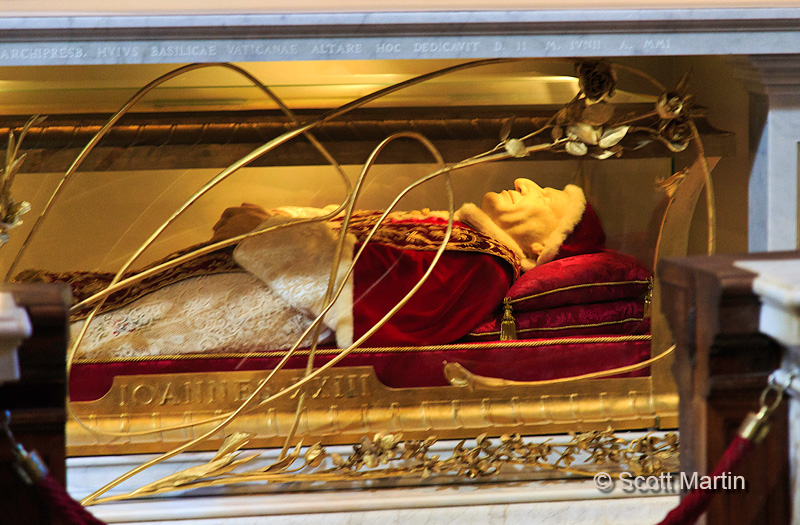
One of the most popular statues in the basilica is Michelangelo’s Pieta which was carved in 1498-1499 when Michelangelo was only 24. It is the only piece of art he ever signed.
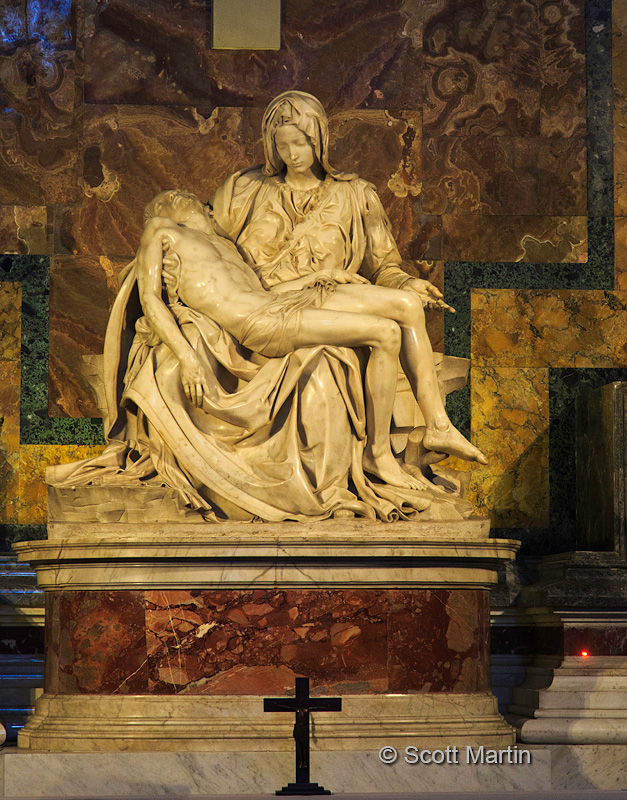
The dome above the Papal Altar is the highest dome in the world with the top of its external cross 450′ above the floor of the basilica and its internal diameter is just over 136′. This next image shows the dome from the inside looking up into the cupola.
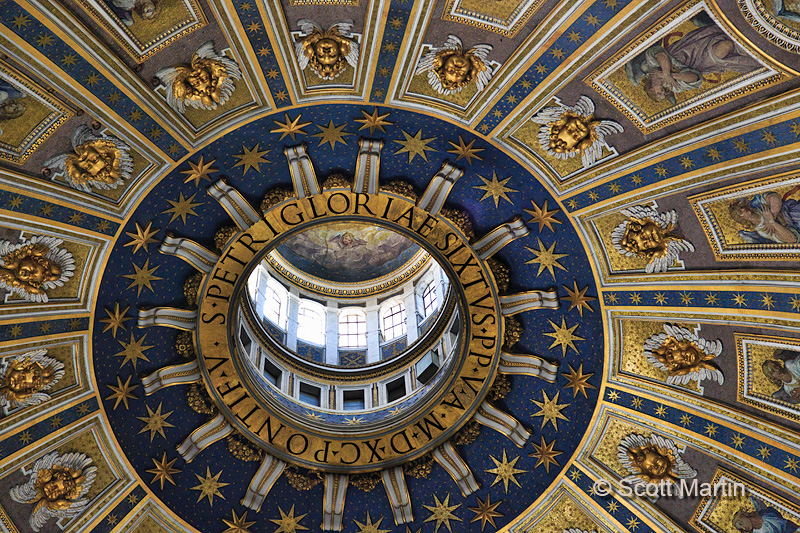
And from the top looking down into the basilica towards the Altar of St. Joseph, which is said to contain the relics of Simon and Jude in an ancient sarcophagus.
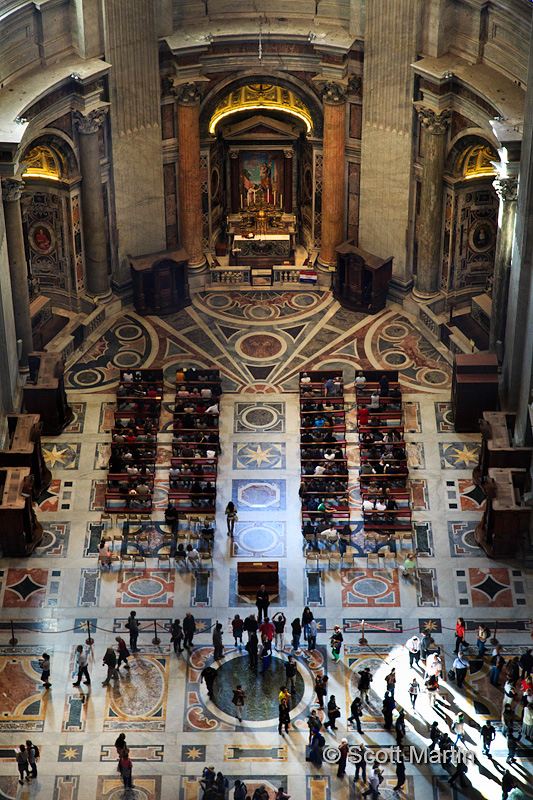
There is an extra fee required to visit the actual dome of St. Peter’s Basilica and then climb the more than 500 steps winding through the inner and outer dome shells, eventually arriving at an outside viewing area at the top of the cupola of the dome. The view from this vantage point is well worth the effort required to get there, although if claustrophobic it may prove a problematic journey.
Looking up towards the top of the dome from within the inner and outer walls.
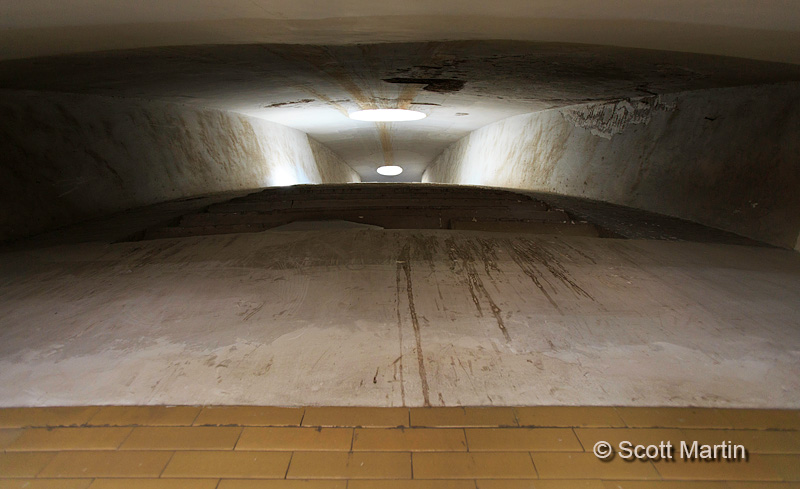
The dome as seen from the roof of the basilica. The viewing rail is at the base of the cupola on the top of the dome.
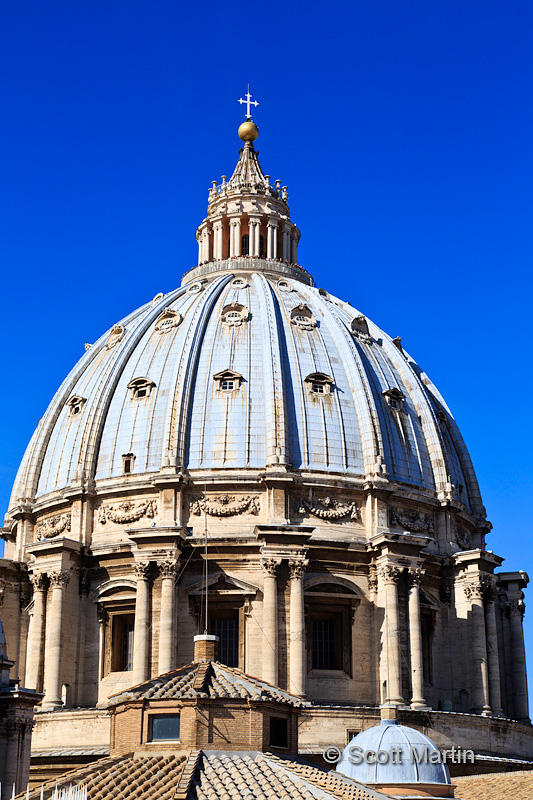
A closer view, which also provides some perspective as to the enormous size of the dome.
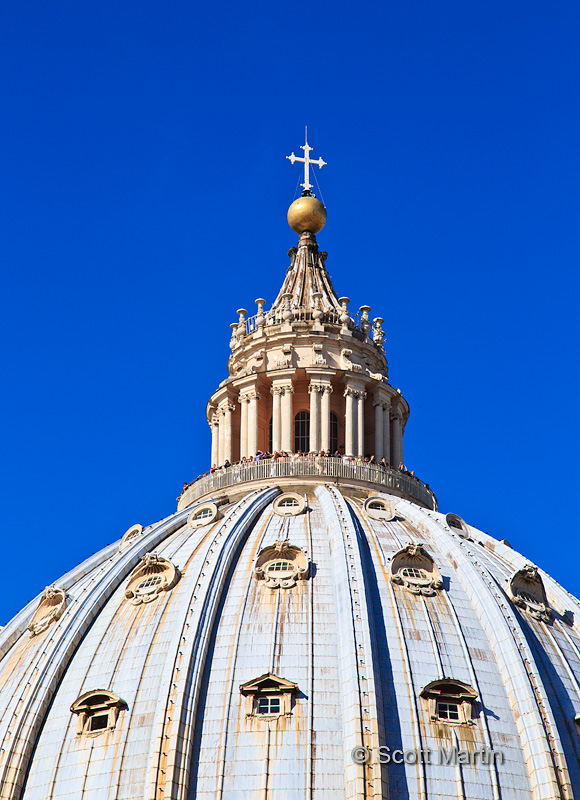
The spectacular view of St. Peter’s Square with its central obelisk and the surrounding Roman countryside as viewed from the top of the dome.
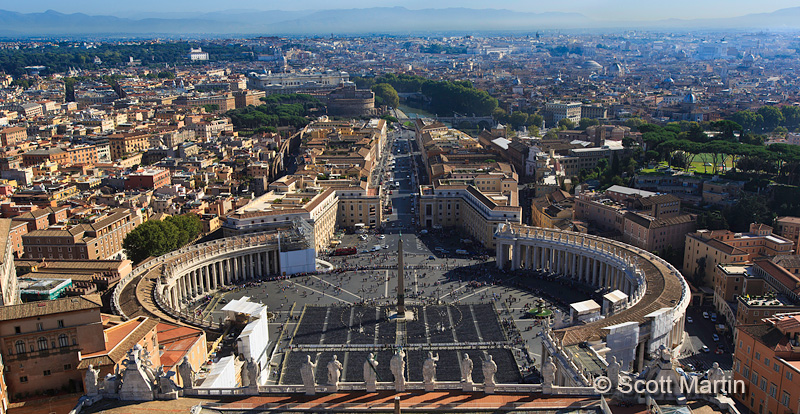
Across the top of the front facade of the basilica are thirteen travertine statues, the largest being Christ standing 19′ in height and flanked by John the Baptist and eleven apostles. Interestingly, the missing apostle is Peter.

Originally I had planned to do one post on the Vatican City however given the length of this blog entry it is probably best I stop at this point and continue on with the Vatican Museum and Sistine Chapel in another post.
Thank you for working your way through this post and I trust you’ve learned something new about the Vatican.
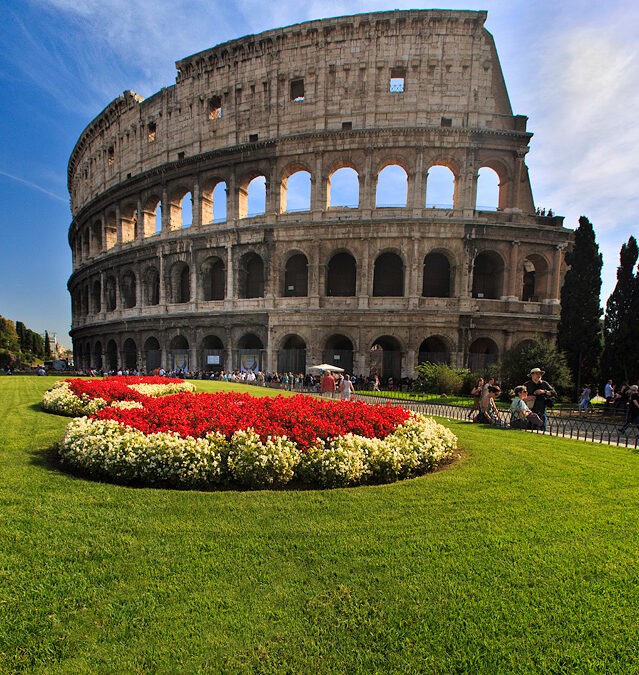
by Scott Martin Photography | Jan 23, 2013 | Blog, Cityscapes, Educational, Landscapes, Travel
After flying all night from Toronto and arriving in Rome early in the morning, we checked into La Piccola Maison (a perfect place to stay in the heart of the city within walking distance of everything) and then headed for the Colosseum where we spent the rest of the day. Our path to the Colosseum took us right by the Trevi Fountain where we stopped and had our first gelato!
It was quite the feeling to be walking along the Via Dei Fori Imperiali and see the Colosseum coming into view for the first time, certainly the oldest structure we’d ever seen, having begun construction in 72 AD and completed under Titus in 80 AD. Here are our first views of the Colosseum.

.
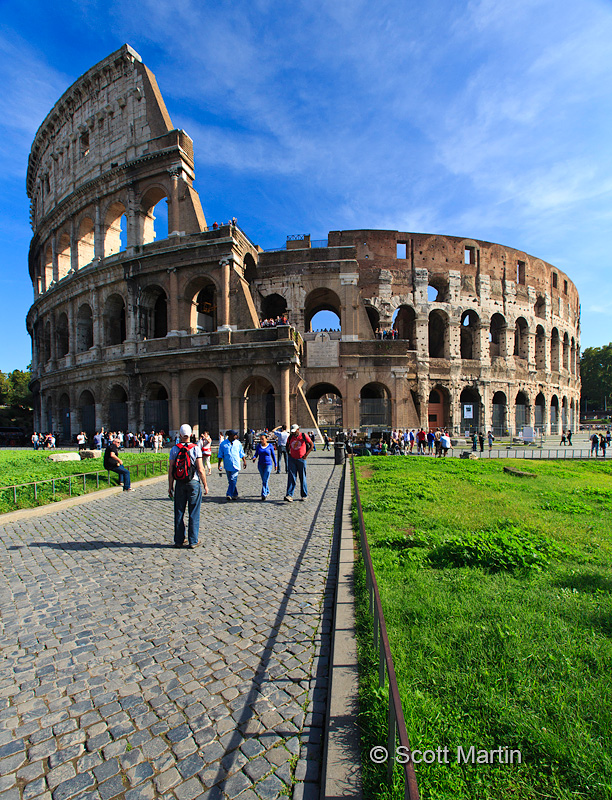
The Colosseum is a huge oval amphitheatre capable of seating 50,000 spectators. It is 615′ long, 510′ wide and stands 157′ tall, having a base that occupies more than six acres. The outer walls were made of travertine stone and no mortar was used in the construction. The stonework was held together with bronze clamps, most of which have been pried and torn out for other uses. This has resulted in the pock marks that remain today as seen below.
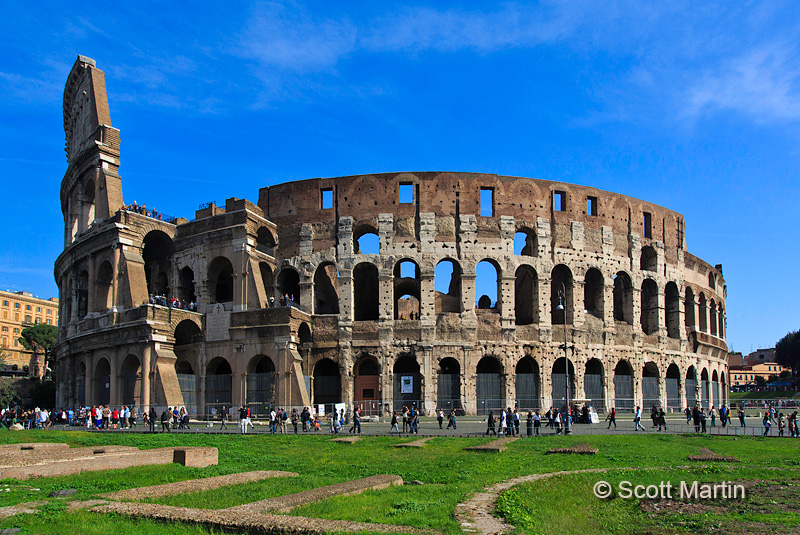
The interior floor of the Colosseum measures 287 x 180′. The floor was a wooden floor covered by up to a foot of sand. Our tour guide relayed the morbid information that the sand was required to absorb the blood shed in Colosseum events, both of wild animals and humans. It is recorded that 9,000 wild beasts were killed in the inaugural event in 80AD. Below the wooden Colosseum floor is the two-story area known as the hypogeum, which is shown next. The East end of the floor has been re-created, leaving most of the hypogeum visible.
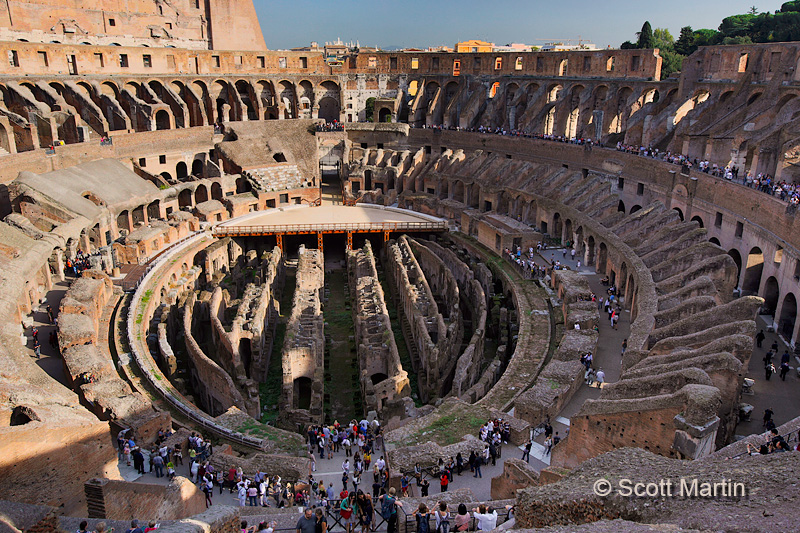
.
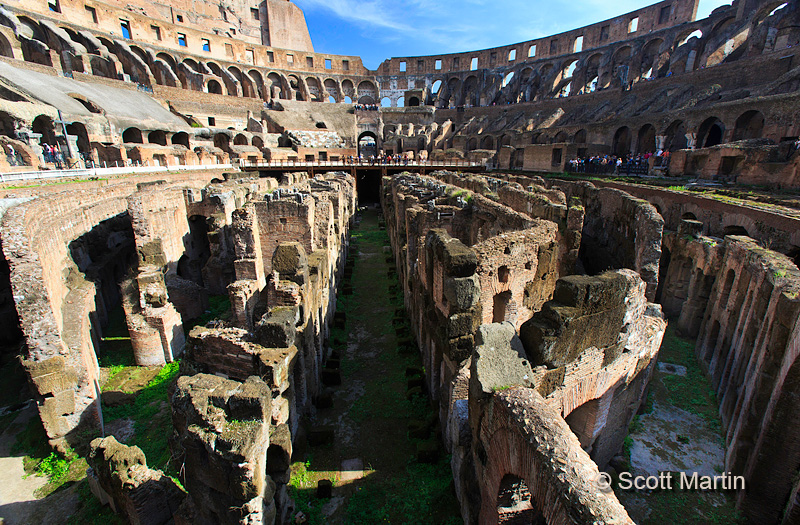
Until last year access to the hypogeum was not possible, however by purchasing special tickets you are now able to join a guided tour of the hypogeum as well as go up to the third level of the Colosseum, neither of which are possible with the general admission ticket. Although it more than doubled the cost of visiting the Colosseum it was an amazing experience to go down below the floor level into the hypogeum. Unfortunately the images you will see can not come even remotely close to portraying the feeling you get while standing there walking along the same pathways that countless Christians walked as they headed to the elevators used to push them up onto the arena floor where they were killed for sporting spectacle before 50,000 people.
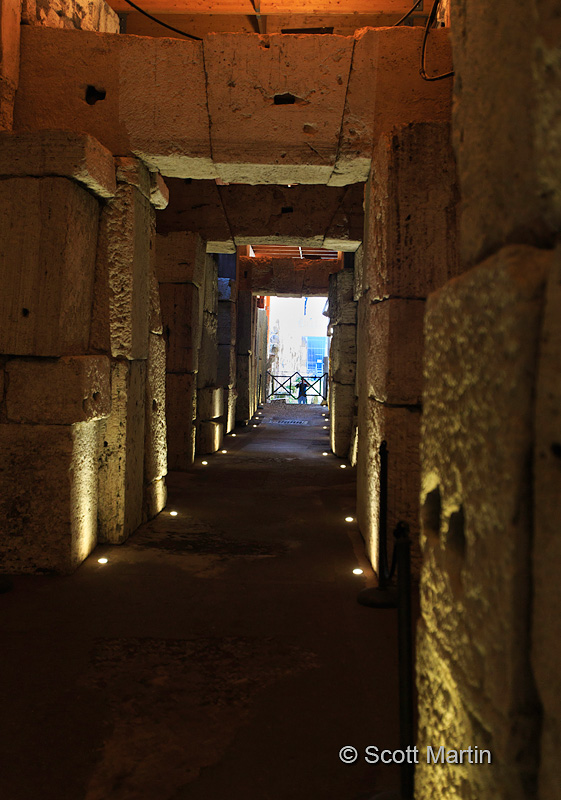
(Aside: A couple of things to note regarding the above photograph, the first being the lack of mortar and the use of keystones in the arches of the walkway to provide the necessary structural integrity. Secondly this shot was taken as an ‘in-camera’ three shot HDR, meaning that with one press of the shutter, the camera takes three images, one at the metered exposure, one (in this case) three stops underexposed and another three stops overexposed. The camera then combines the three images into one new image and deletes the three originals. This HDR (High Dynamic Range) technique has been in use for years however the processing was always done on the computer using Photoshop and taking a lot of time. With today’s new cameras it can be done in a few seconds right in the camera.)
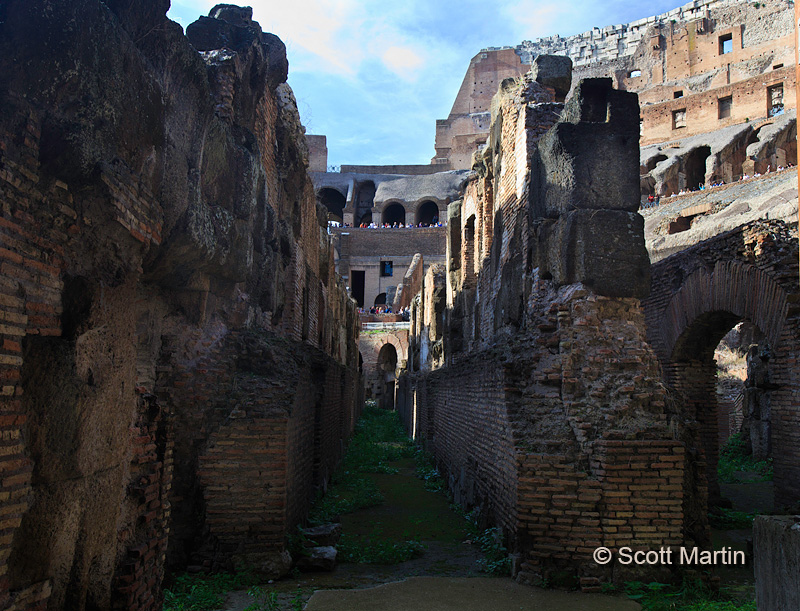
The next image shows the outer wall of the hypogeum and along the pathway you can see travertine slabs which are bases for a complex elevator system that was used to move wild animals, people, and large stage props, from the hypogeum up onto the arena floor. It is thought that the elevators were moved by rope and pulley systems that were manned and operated by slaves who either lived in the hypogeum or were brought in through tunnels to work the elevators.
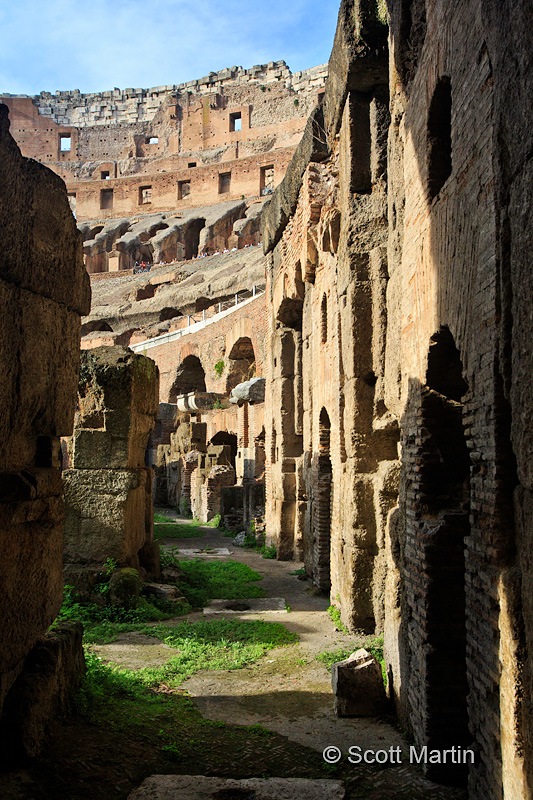
A close up of an elevator shaft support, this one is #8 of eighty found in the Colosseum.
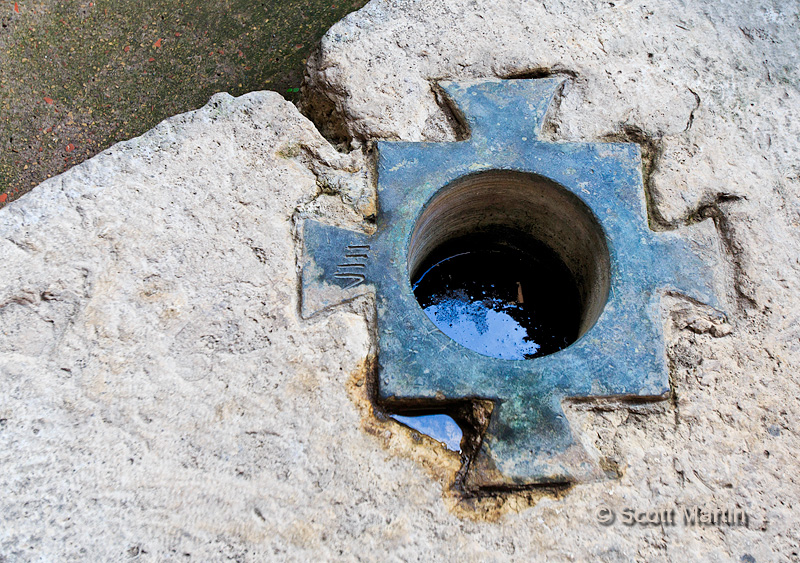
It’s hard to believe this walkway is almost two thousand years old.
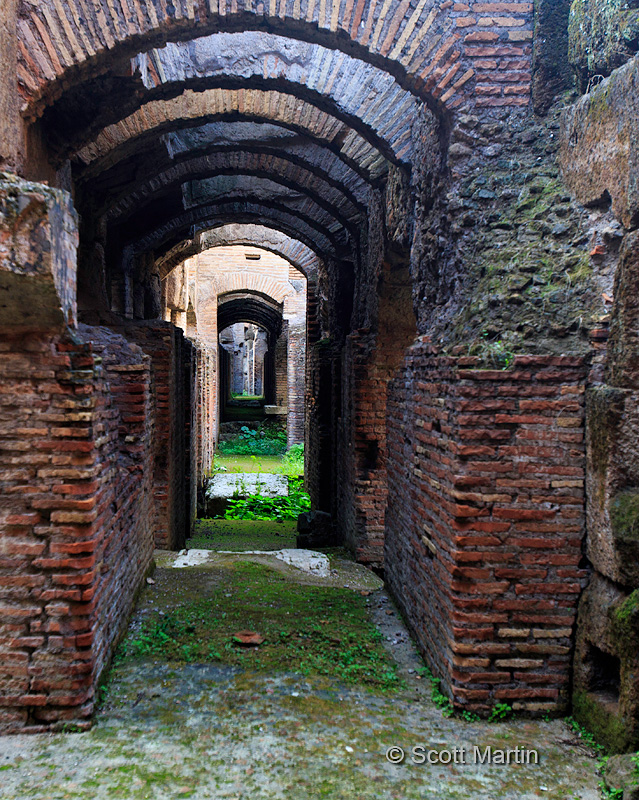
The Colosseum was known for its ability to quickly get spectators into and out of the building, in fact there are eighty arches leading into the amphitheatre, seventy-six for regular people and four large arches for the elite. Below is the East arch, through which the Senators entered and headed to their private seating area, which is shown in the second image below. Each white marble slab is the base for a senator’s chair and many of these slabs have the various senator’s names engraved on them. You can also see the senator’s seating area and the East arch in the fourth and fifth images in this blog post.
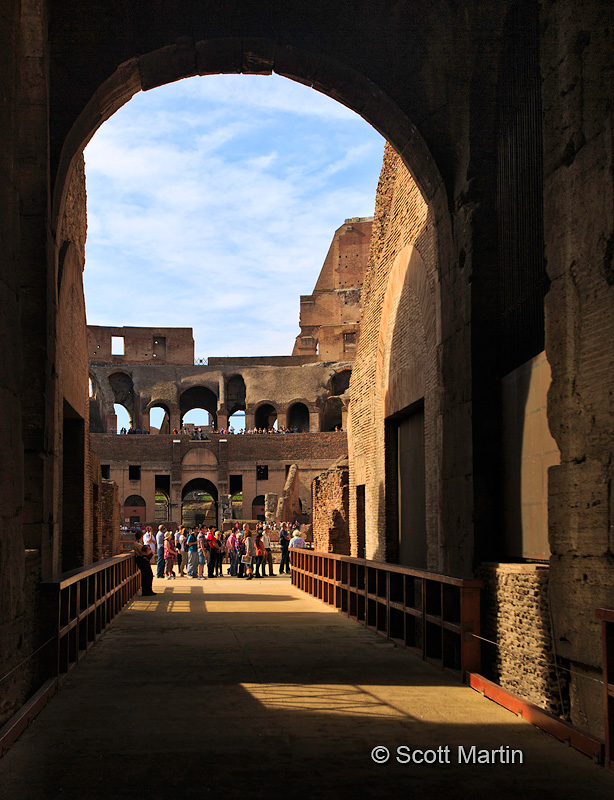
.
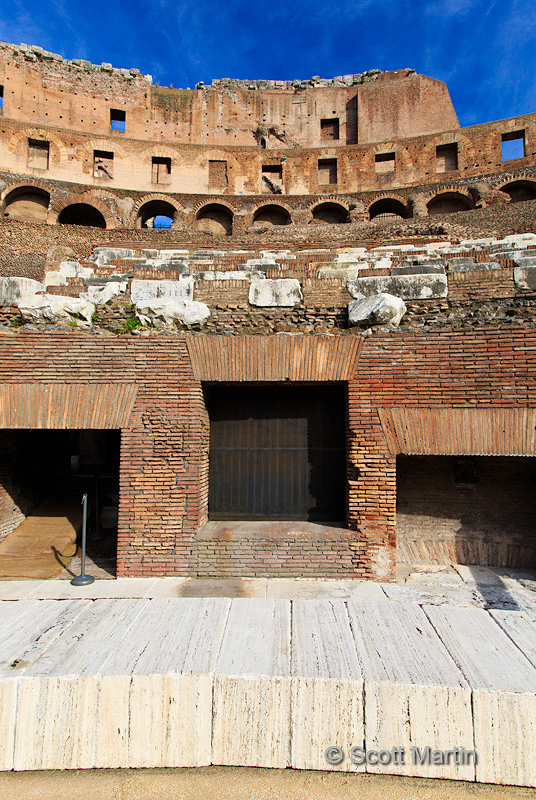
Here is one of the much smaller 76 entrance arches used by the commoners.
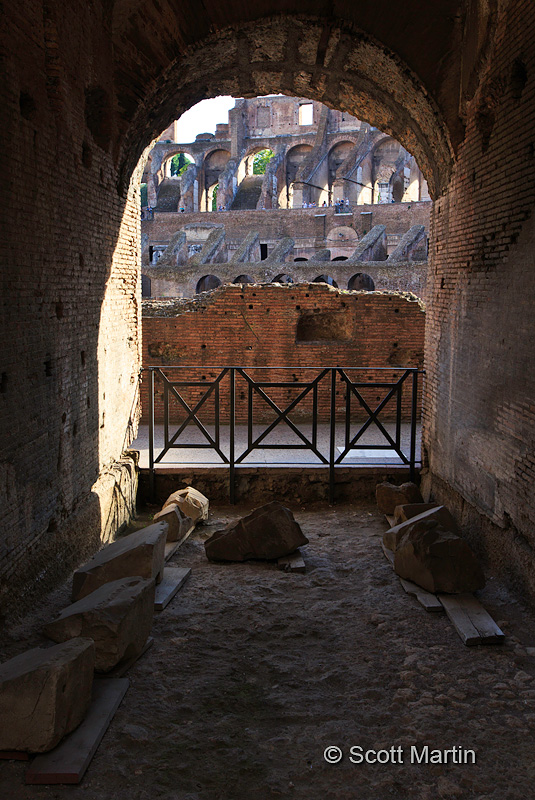
The climb to the third level of the Colosseum provided a wonderful birds eye view of the amphitheatre.
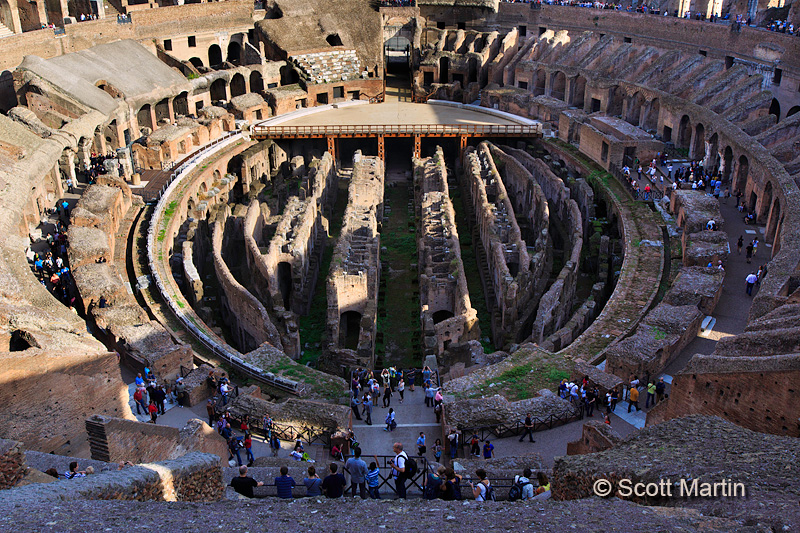
Another view from the stairwell between the second and third levels.
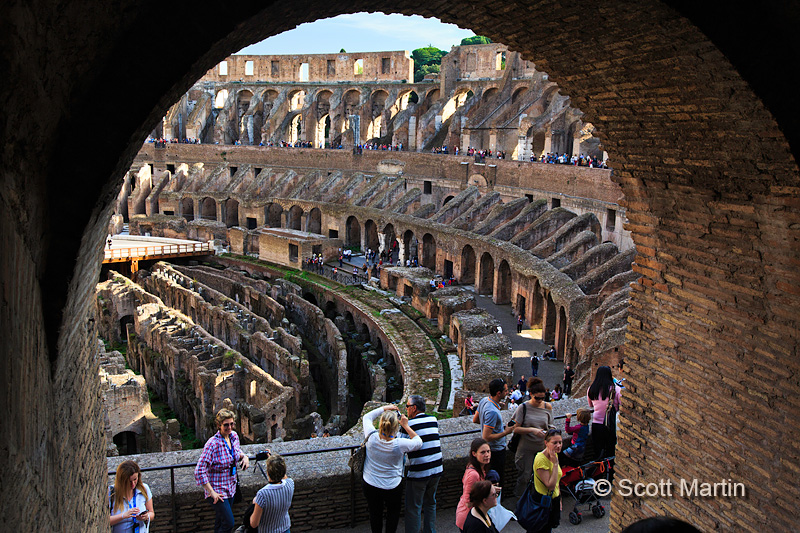
The last gladiatorial fights were circa 435 and the last recorded animal hunts around 523. By the end of the sixth century a church was incorporated into the Colosseum and a cross erected for the first time. Since then the Colosseum has been used in many different ways and certainly makes for interesting reading if you are so inclined.
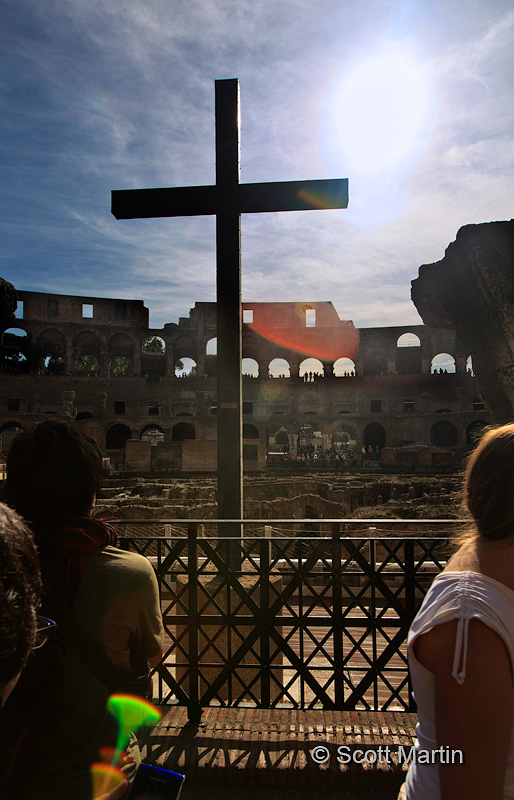
Our first day in Rome was terrific and spending a few hours in the Colosseum was an experience like none other. We even took time to pose like the tourists we were!
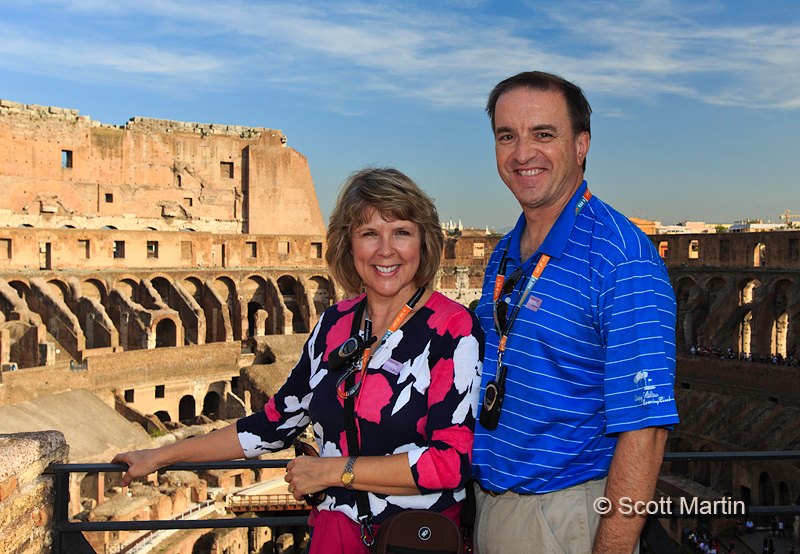
One final shot of the Colosseum.
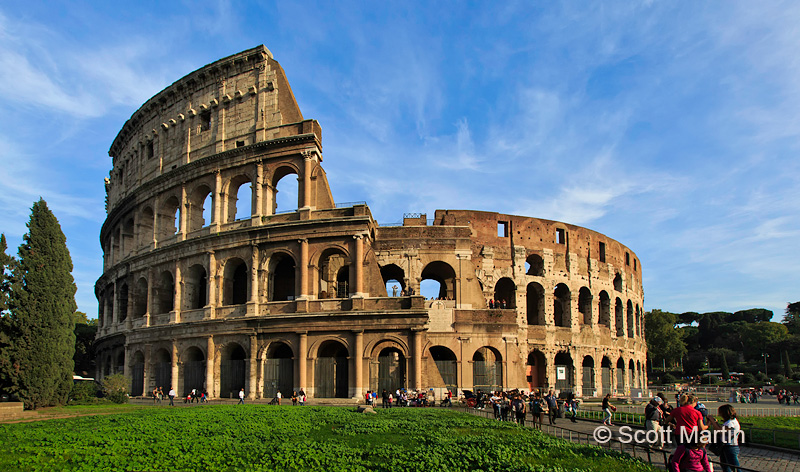
All of the images taken in this post were with the Canon 5D Mk III and either 16-35 or 24-105mm lenses. Larger size versions of the images in this post can be seen in the Rome gallery.
Thanks for taking time to look through these images of the Roman Colosseum and as always your comments are much appreciated.
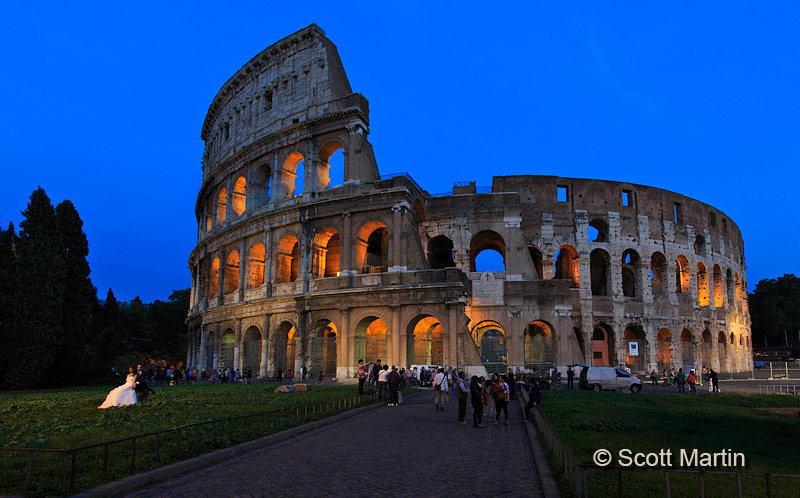
by Scott Martin Photography | Jan 3, 2013 | Blog, Cityscapes, Educational, Landscapes, Travel
Last fall Deb and I celebrated our thirtieth wedding anniversary touring though as much of Europe as we could possibly cover in seventeen days. It was a fabulous trip that saw us accumulate over 4,500 km on our rental car and see so many fabulous sights that had it not been for photographing as much of it as possible we surely couldn’t remember everything! Over the upcoming weeks we will try to post some of the highlights of our trip on the blog and will also post the images in the travel section of the website gallery.
We began our trip in Rome and spent our first afternoon in Italy touring the Colosseum, which was a truly amazing experience. The emotions you feel as you are guided through the hypogeum (underground levels of the Colosseum) are indescribable as you recall in a way that is not possible by reading a book, or studying in school, the events that occurred in the very place you are standing some two thousand years ago.
The next blog post will include more of an informative photographic description of the Colosseum and its history however for now I would like to post a few images of the Colosseum taken at night. They are posted in chronological order so you can see the sky darkening in each image.
Night photography is a lot of fun and as long as you have the correct equipment and know a little of the technical fundamentals it’s not very hard to get some interesting pictures. The most important piece of gear for night photography is a good tripod. It is impossible to hand hold a camera in the low light of the evening and get a good sharp image as the exposures required are just too long. From a technical perspective you may find the following helpful; try to take night shots while there is still blue in the sky as once the sky is black all detail is lost and the edges of the subject are lost in the darkness; use a low ISO (200 or less) to help reduce the noise in the image which is always more noticeable in the dark colours that dominate night photography; use a small aperture (f/22) for great depth of field so everything remains in sharp focus throughout the image. A small aperture also creates the starburst effect on light sources that many people enjoy seeing.
It is impossible to shoot the Colosseum without people milling about however you try your best to wait until there are no people in the foreground. In this case having a bride and groom in the picture adds to the appeal of the image.

Most night images are taken in landscape orientation however experiment with a vertical perspective as well, especially if you can incorporate something of interest in the foreground. In this case the large cobblestones which have probably been there for almost two thousand years….you cant help but wonder who has walked on those very stones.
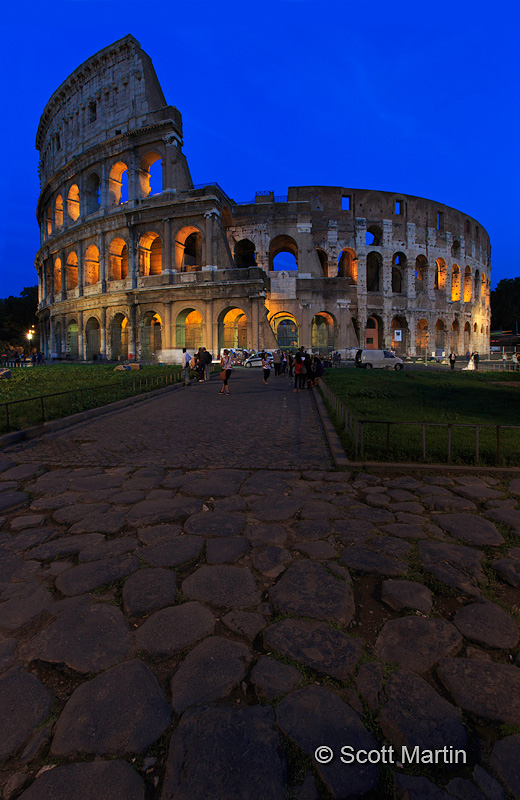
.
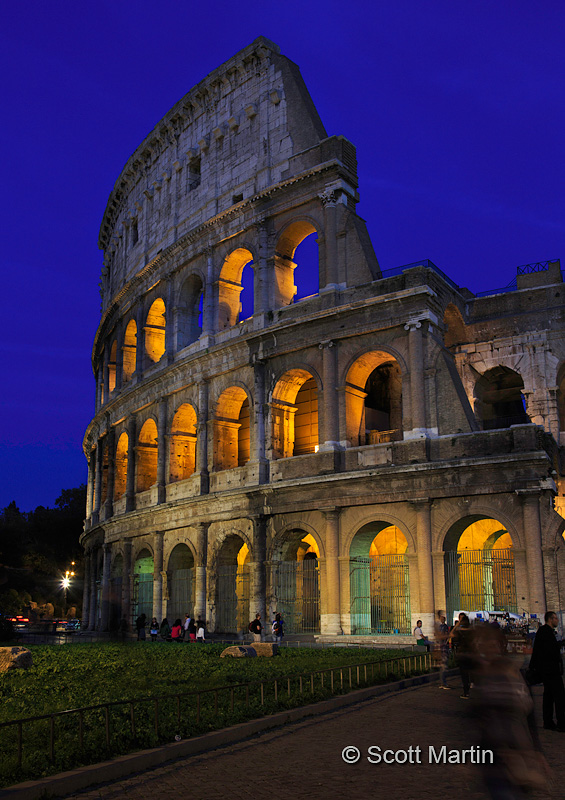
The next image is not in keeping with the others however is a reminder that it’s always good to experiment with different perspectives of the same subject when taking shots at night, even if it means changing lenses to zero in on a specific area that interests you. The next image has also been processed differently in an attempt to portray the age of the building.
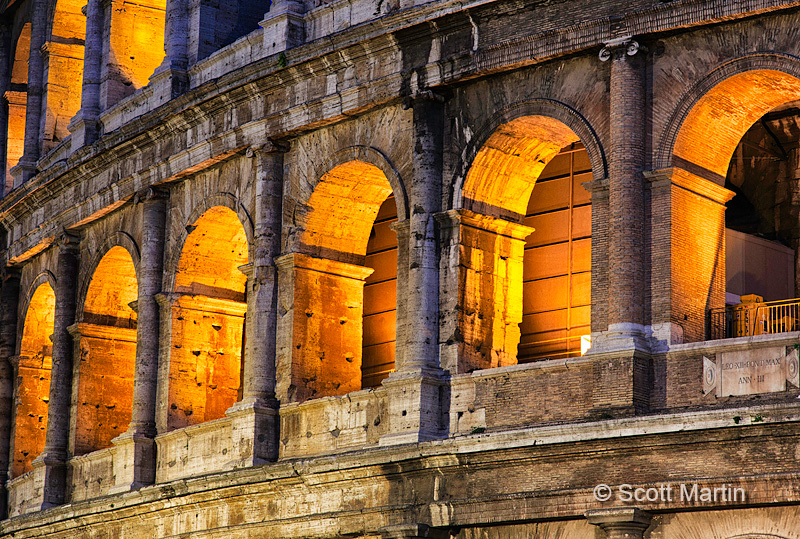
.
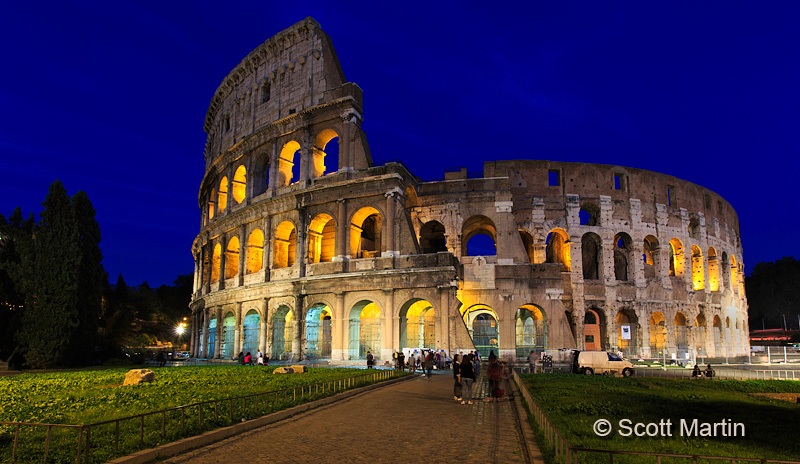
The next image was also designed to include the couple on the left and although they are very blurry because of the twenty-second exposure, they do add to the image.
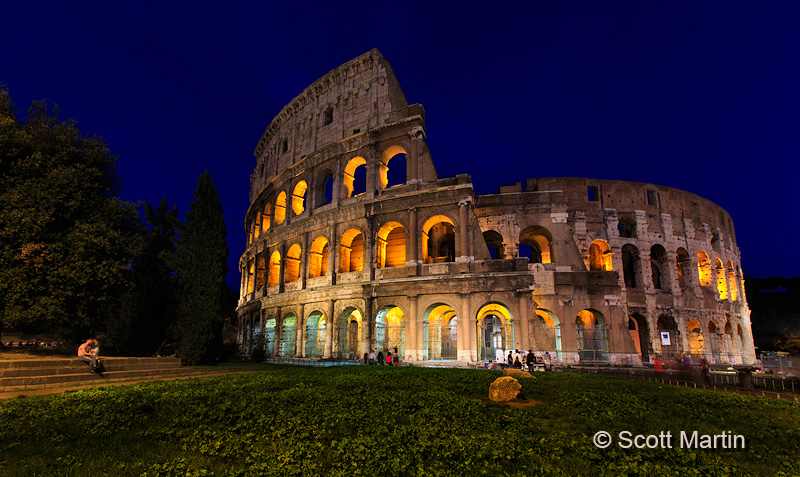
By now the sky is almost devoid of blue so its time to pack up or in this case move to another location and shoot images that don’t rely on the background to be effective. When the sky becomes black make sure you always have a foreground object that provides plenty of interest compositionally; the flower bed in the next image and the streaming lights from the traffic in the last.
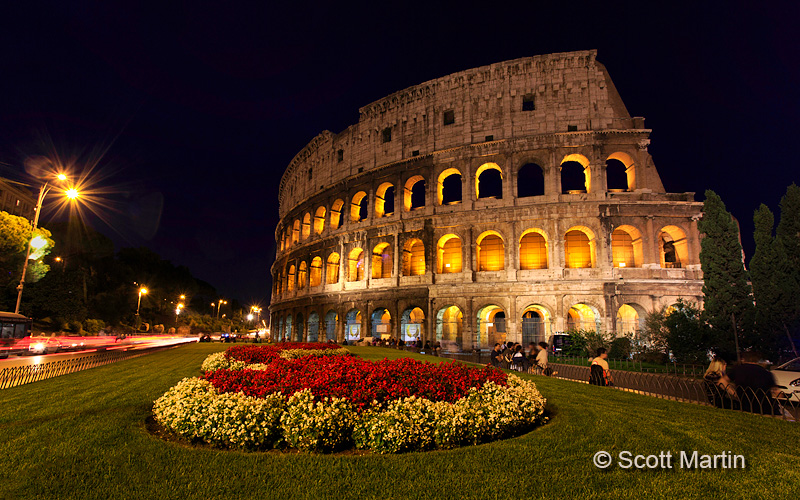
.
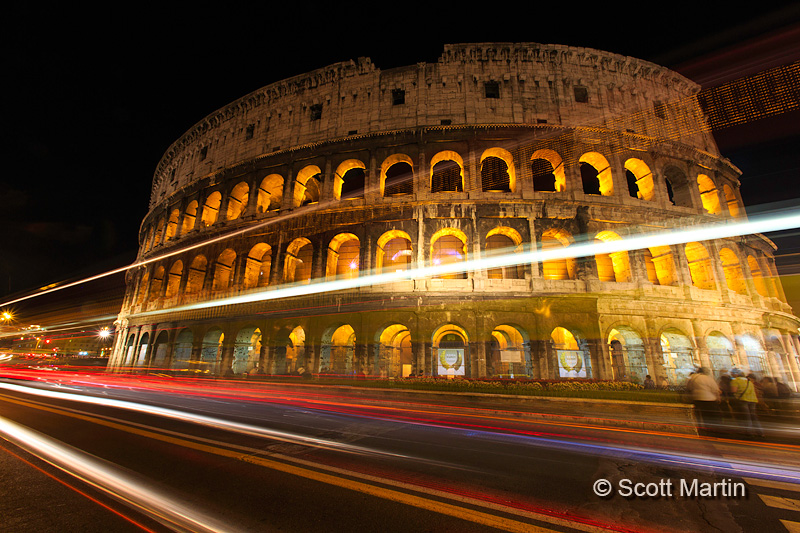
All of the images in this post were taken using a Canon 5D Mk III on a Gitzo 1542T tripod using a 16-35mm or 24-105mm lens. If you have any questions regarding the taking of these images please leave a comment and I’ll be glad to respond. In the mean time, dust off that old tripod and start practicing night photography and I know you will be pleased withy the results.
by Scott Martin Photography | Oct 21, 2012 | Blog, Cityscapes, General, Landscapes, Travel
It has been far too long since my last blog post and I apologize for the tardiness, however there will be lots of material coming over the next few months.
Presently Deb and I are enjoying a vacation celebrating our thirtieth wedding anniversary. Its been a fabulous thirty years and the time has flown by but that’s what happens when you are married to your best friend! We arrived in Rome just over two days ago and are now enjoying our first of two nights in Venice. In the morning we are meeting up with Marco Secchi for a photographic tour of Venice. We can’t wait as Marco shows us the sights of Venice from a professional photographers standpoint, and as a photographer who grew up and lives in Venice he is uniquely qualified to do so.
Although we won’t be able to post any DSLR shots while on vacation, Deb and I have been also snapping away with our iPhone’s and they really do remarkably well. I have already posted some of the images taken so far onto the Scott Martin Photography Facebook page and if you haven’t already done so, please ‘like’ this page and check out some of the images from Europe. There are some images of the Colosseum and St. Peter’s Square in the Vatican.
45.44141812.328264
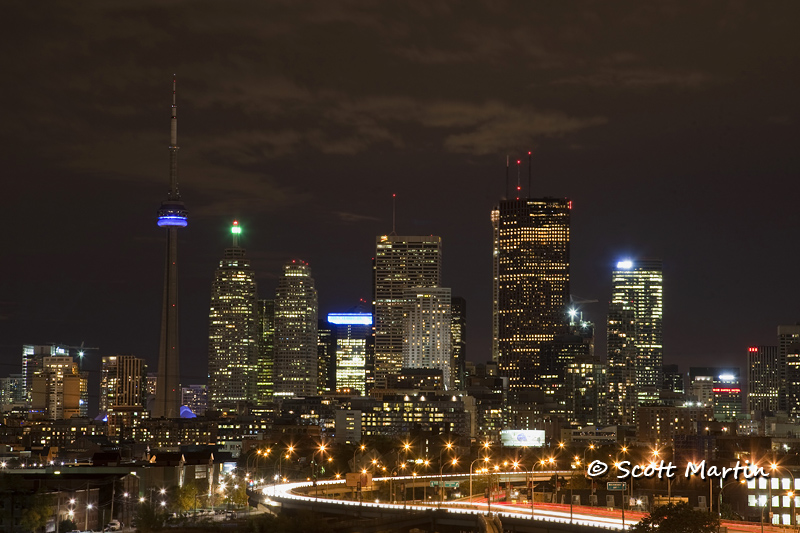
by Scott Martin Photography | Dec 5, 2010 | Blog, Cityscapes, Landscapes
October 2, 2010 marked the date for the fifth Nuit Blanche dusk to dawn contemporary art event. The event is held on the weekend before the Canadian Thanksgiving Weekend and has been growing each year since its inception in 2006 with more than a million people this year enjoying the exhibitions setup in various zones throughout the Toronto Downtown core. Most of the exhibitions involve light and the downtown buildings are often lit differently for Nuit Blanche, including the CN Tower. The concept of Nuit Blanche did not originate in Toronto, with the first organized events beginning in 1997. Controversy exists as to who started the very first Nuit Blanche – Paris, St. Petersburg or Berlin.
This year we spent the evening of Nuit Blanche at a good friend’s 50th birthday party, held at their downtown condominium which provided a beautiful view of the Toronto night-time skyline. Although cold, a roof-top terrace provided the perfect place to set up the tripod and shoot the Toronto nightscape from the East looking along Eastern Avenue.

When shooting night scenes you really should shoot while there is still blue in the sky. This allows the edges of the buildings to be easily differentiated. When the sky becomes black the edges of the building fade into the back ground and the visual impact of the image is lost. Although these images were take long after dark, they do work well as there is enough stray light from the city centre that the building edges are illuminated.
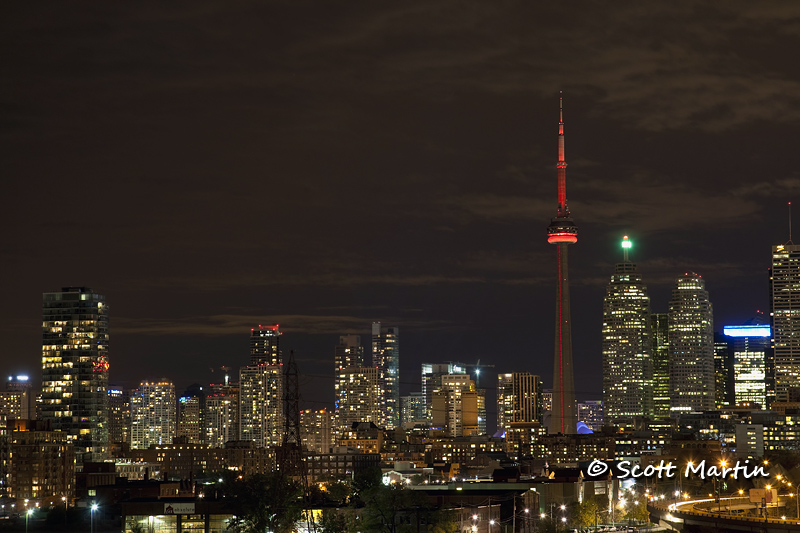
Thanks to Nuit Blanche the CN Tower is red!
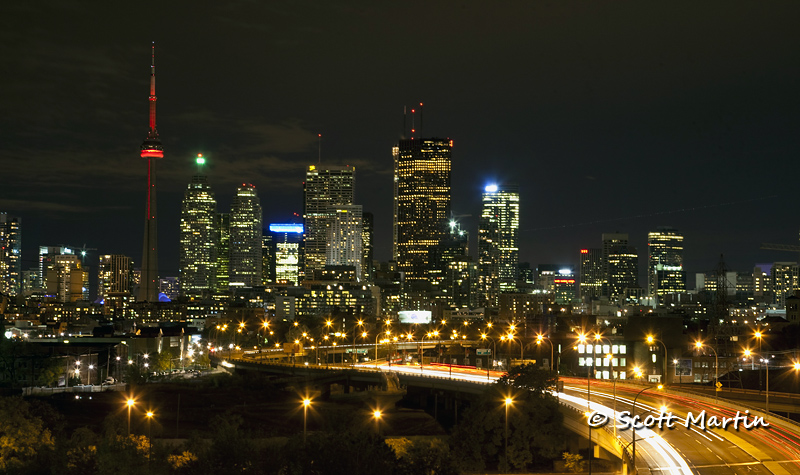
The star burst effect around the street lights is created by using a small aperture and as the aperture diameter increases the starburst effect is lost. You can also create the same effect with a star-cross filter, however that is more expensive and less fun than learning how to use aperture to control the star burst effect. The small apertures causes the exposure time required to increase significantly, however that is why you always have a tripod available.
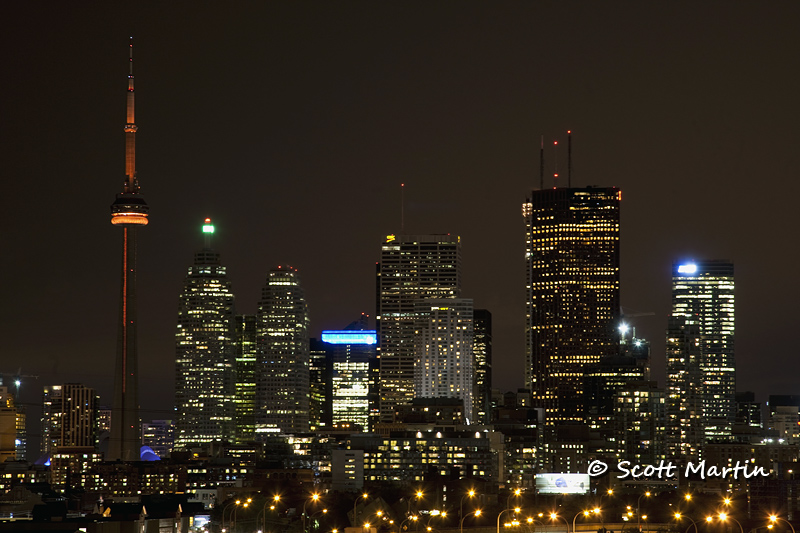
You can see other Cityscapes in the Cityscapes Gallery. There are some night shots of the Washington Capitol Building which will illustrate the value of shooting night scenes while there is still some blue in the sky.





































































Follow Scott Martin Photography